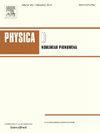Spontaneous symmetry breaking and vortices in a tri-core nonlinear fractional waveguide
IF 2.7
3区 数学
Q1 MATHEMATICS, APPLIED
引用次数: 0
Abstract
We introduce a waveguiding system composed of three linearly-coupled fractional waveguides, with a triangular (prismatic) transverse structure. It may be realized as a tri-core nonlinear optical fiber with fractional group-velocity dispersion (GVD), or, possibly, as a system of coupled Gross–Pitaevskii equations for a set of three tunnel-coupled cigar-shaped traps filled by a Bose–Einstein condensate of particles moving by Lévy flights. The analysis is focused on the phenomenon of spontaneous symmetry breaking (SSB) between components of triple solitons, and the formation and stability of vortex modes. In the self-focusing regime, we identify symmetric and asymmetric soliton states, whose structure and stability are determined by the Lévy index of the fractional GVD, the inter-core coupling strength, and the total energy, which determines the system’s nonlinearity. Bifurcation diagrams (of the supercritical type) reveal regions where SSB occurs, identifying the respective symmetric and asymmetric ground-state soliton modes. In agreement with the general principles of the SSB theory, the solitons with broken inter-component symmetry prevail, as stable states, with the increase of the energy in the weakly-coupled system. Three-components vortex solitons (which do not feature SSB) are studied too. Because the fractional GVD breaks the system’s Galilean invariance, we also address mobility of the vortex solitons, by applying a boost to them.
三芯非线性分数波导中的自发对称破缺和涡流
我们介绍了一个由三个线性耦合分数波导组成的波导系统,其横向结构为三角形(棱柱形)。它可以实现为具有分数群速度色散(GVD)的三芯非线性光纤,或者,也可以实现为一个耦合格罗斯-皮塔耶夫斯基方程组,该方程组适用于由通过莱维飞行运动的粒子玻色-爱因斯坦凝结物填充的三个隧道耦合雪茄形陷阱。分析的重点是三重孤子分量之间的自发对称性破缺(SSB)现象,以及涡旋模式的形成和稳定性。在自聚焦系统中,我们确定了对称和非对称孤子态,其结构和稳定性由分数 GVD 的莱维指数、核间耦合强度以及决定系统非线性的总能量决定。分岔图(超临界类型)揭示了发生 SSB 的区域,确定了各自的对称和非对称基态孤子模式。与 SSB 理论的一般原理一致,随着弱耦合系统能量的增加,具有断裂的分量间对称性的孤子作为稳定状态占主导地位。我们还研究了三分量涡旋孤子(不具有 SSB 特征)。由于分数 GVD 打破了系统的伽利略不变性,我们还通过对涡旋孤子施加助推来解决它们的流动性问题。
本文章由计算机程序翻译,如有差异,请以英文原文为准。
求助全文
约1分钟内获得全文
求助全文
来源期刊

Physica D: Nonlinear Phenomena
物理-物理:数学物理
CiteScore
7.30
自引率
7.50%
发文量
213
审稿时长
65 days
期刊介绍:
Physica D (Nonlinear Phenomena) publishes research and review articles reporting on experimental and theoretical works, techniques and ideas that advance the understanding of nonlinear phenomena. Topics encompass wave motion in physical, chemical and biological systems; physical or biological phenomena governed by nonlinear field equations, including hydrodynamics and turbulence; pattern formation and cooperative phenomena; instability, bifurcations, chaos, and space-time disorder; integrable/Hamiltonian systems; asymptotic analysis and, more generally, mathematical methods for nonlinear systems.
 求助内容:
求助内容: 应助结果提醒方式:
应助结果提醒方式:


